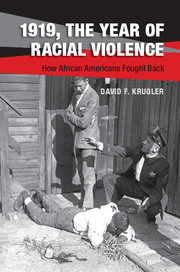Book contents
- Frontmatter
- Dedication
- Contents
- Acknowledgments
- Source Abbreviations and Usage Note
- Introduction
- 1 World War I and the New Negro Movement
- 2 “We Return Fighting”
- 3 Fighting a Mob in Uniform
- 4 Blood in the Streets
- 5 Armed Resistance to the Courthouse Mobs
- 6 Armed Resistance to Economic Exploitation in Arkansas, Indiana, and Louisiana
- 7 “It Is My Only Protection”
- 8 The Fight for Justice
- 9 The Fight for Justice
- 10 Fighting Judge Lynch
- Conclusion
- Bibliography
- Index
- References
Introduction
Published online by Cambridge University Press: 05 December 2014
- Frontmatter
- Dedication
- Contents
- Acknowledgments
- Source Abbreviations and Usage Note
- Introduction
- 1 World War I and the New Negro Movement
- 2 “We Return Fighting”
- 3 Fighting a Mob in Uniform
- 4 Blood in the Streets
- 5 Armed Resistance to the Courthouse Mobs
- 6 Armed Resistance to Economic Exploitation in Arkansas, Indiana, and Louisiana
- 7 “It Is My Only Protection”
- 8 The Fight for Justice
- 9 The Fight for Justice
- 10 Fighting Judge Lynch
- Conclusion
- Bibliography
- Index
- References
Summary
“In view of the sacrifices the negro soldiers made in this war to make the world safe for democracy it might not be a bad idea to make the United States safe for democracy.”
– Colonel William Hayward, commanding officer of the 369th Infantry Regiment, Ninety-third Division (a.k.a. the Harlem Hellfighters), speaking in May 1919Aaron Gaskins was fed up. Never again would he submit to the pressure to buy Liberty Loans. Not one day more would he sit meekly at the back of the electric train during his morning commute from Alexandria, Virginia, to Washington, D.C. And no longer would he keep quiet about these indignities. On October 9, 1918, as his train crossed the Potomac River, Gaskins strode to the front and announced to the startled passengers: “I am as good as white people riding in this car.” Gaskins, a tall black man with a scar on his cheek, loudly asked why he could not have the same rights as whites. Every morning he boarded the train with them in Alexandria and yet, because of the color of his skin, had to sit in the back until the car entered Washington. And this in the country that, Gaskins said, had just forced him to buy a bond for the war to make the world safe for democracy. “After this war is over,” he proclaimed, referring to World War I, “we are going to get our rights – we will have a race war if we don’t.”
Gaskins’s statement alarmed engineer William Smith. The federal government had warned Americans that the enemy, Germany, would try to damage homefront morale. To Smith, a black man demanding his rights in public seemed just the sort of trouble Germany might stir up, and he promptly reported the incident to the War Department’s Military Intelligence Division. It dutifully investigated but found no evidence that German propaganda had swayed Gaskins. He led a modest life, worked at Washington’s Union Station, and boarded in a house in Alexandria. The war ended a month later, and investigators dismissed the incident as the outburst of one angry black man.
- Type
- Chapter
- Information
- 1919, The Year of Racial ViolenceHow African Americans Fought Back, pp. 1 - 14Publisher: Cambridge University PressPrint publication year: 2014



